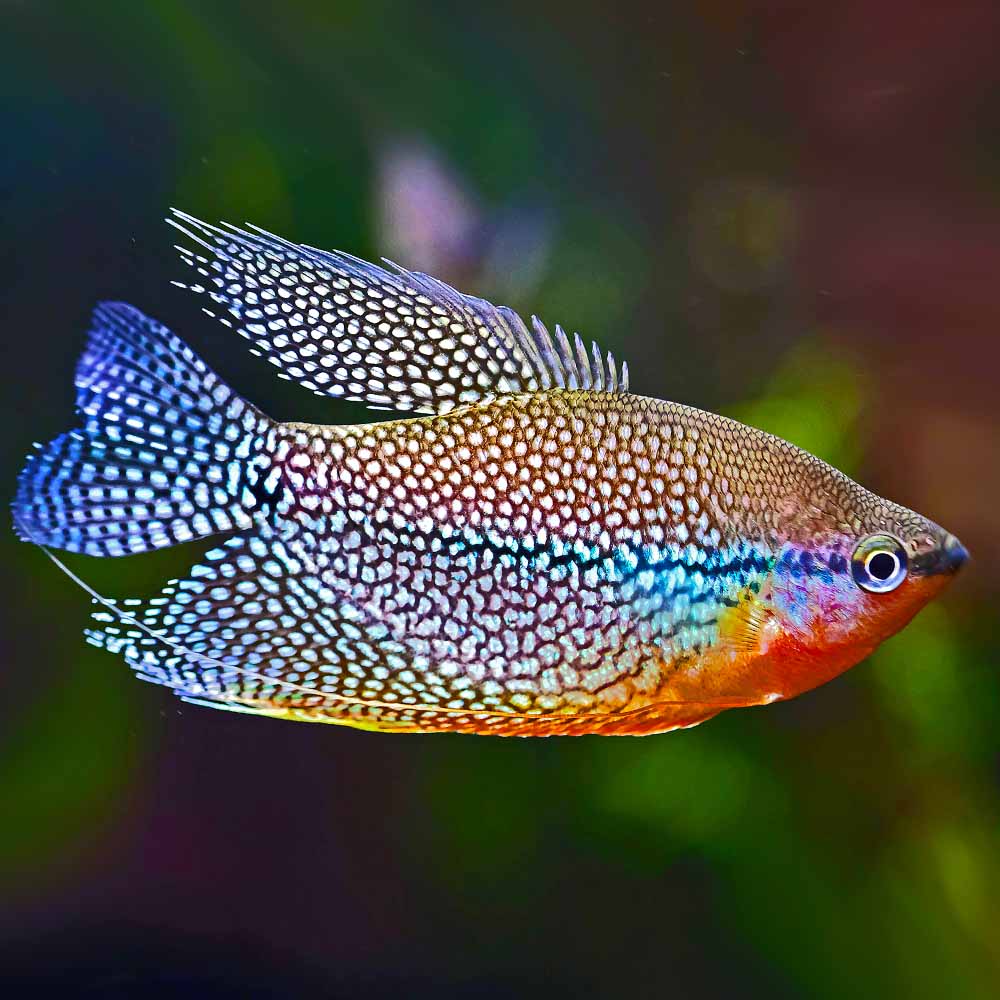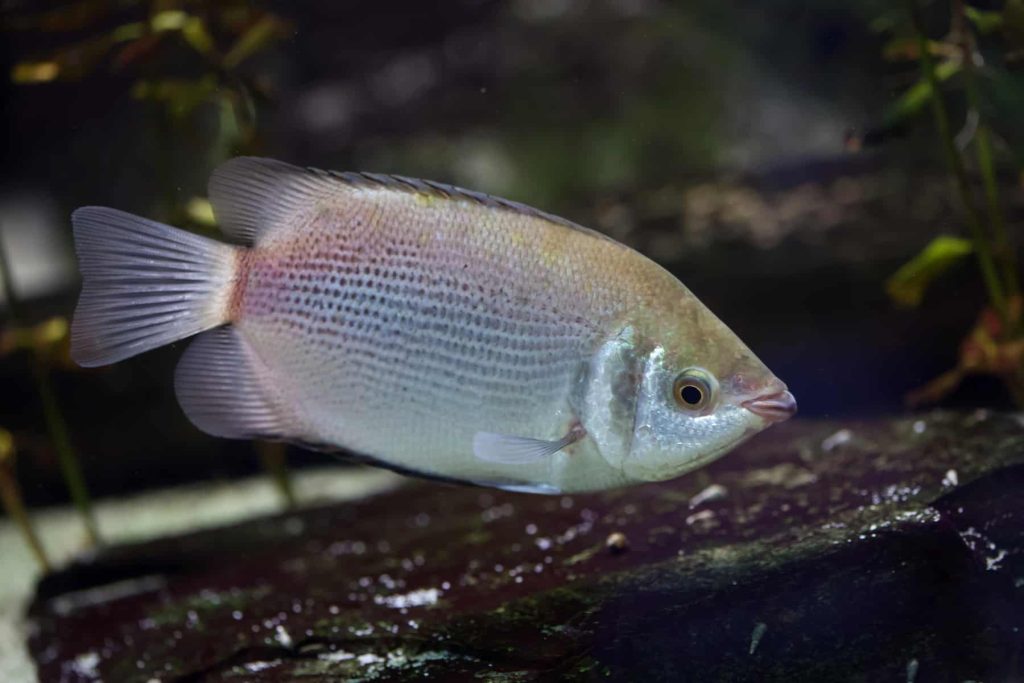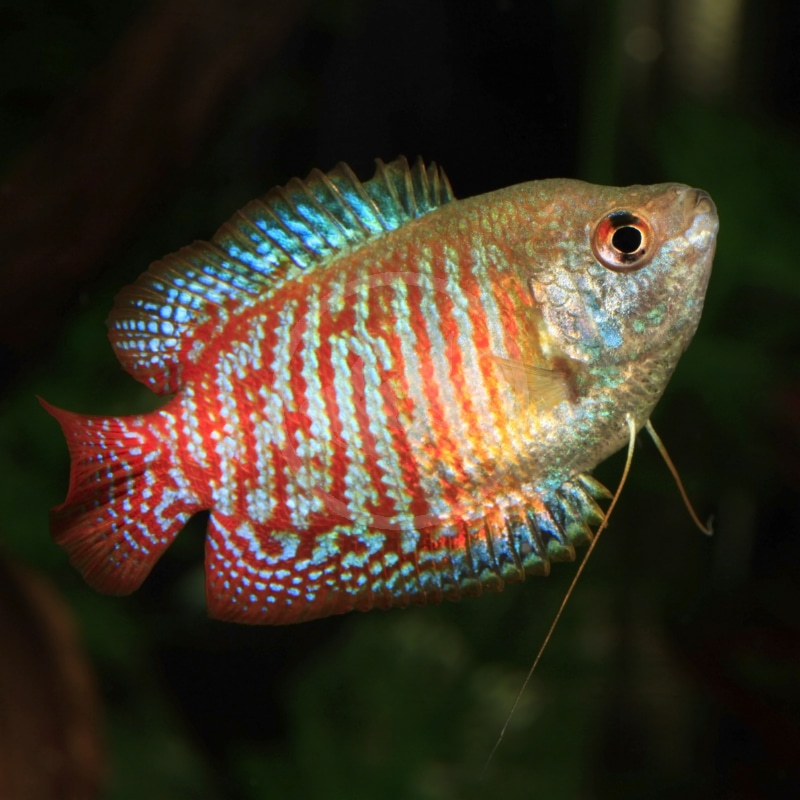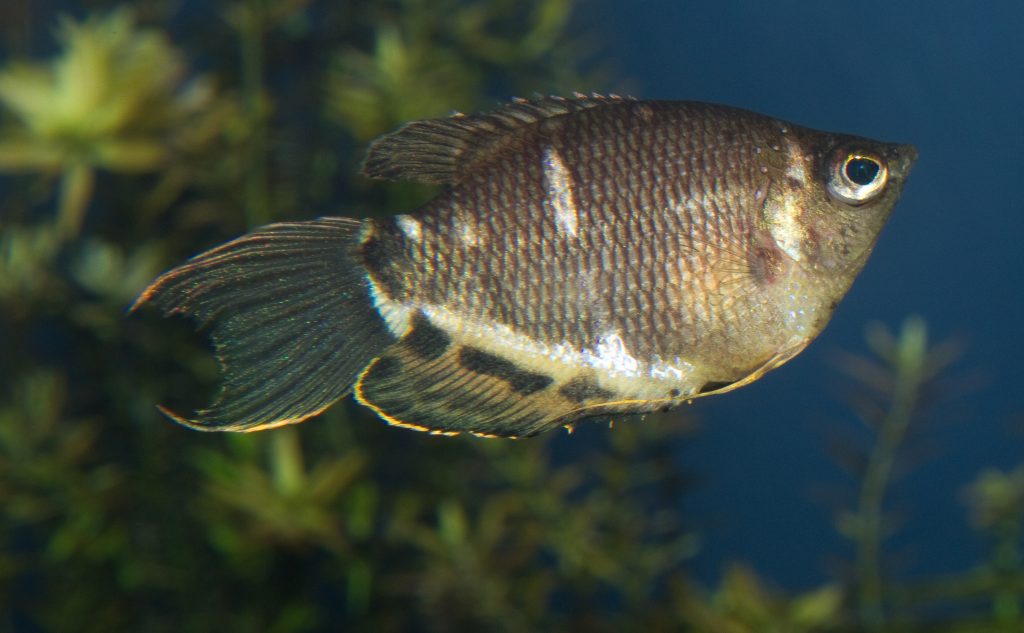Gouramis are a fascinating family of freshwater fish that have charmed aquarists for decades. With their vibrant colors, distinctive shapes, and unique behaviors, they’re not just fish—they’re personalities in your tank. But what makes these fish truly special is their ability to bridge two worlds: the wild waters of Southeast Asia and the carefully curated aquariums of enthusiasts worldwide. Let’s dive into the world of Gouramis, exploring their natural habitats, their diverse types, and how to care for them in aquariums.

Graceful and serene: A Pearl Gourami (Trichopodus leerii) showcasing its intricate, pearlescent pattern and elegant fins. Photo: McMerwe
Gouramis in the Wild: Masters of Survival
In their natural habitat, Gouramis are masters of adaptation. They hail from the slow-moving rivers, swamps, and rice paddies of Southeast Asia, including countries like Thailand, Indonesia, and India. These waters are often oxygen-poor, but Gouramis have evolved a brilliant survival tool: the labyrinth organ. This specialized structure allows them to breathe air directly from the surface, making them highly resilient in conditions where other fish might struggle.
Imagine a tranquil, sun-dappled swamp, the water surface teeming with floating plants. Beneath the greenery, a Giant Gourami glides gracefully, its fins undulating like silk ribbons. Nearby, smaller Dwarf Gouramis weave through submerged roots, their vibrant hues flashing in the filtered sunlight. This is the world Gouramis call home—a world of quiet beauty and hidden drama.
Types of Gouramis: A Diverse Family
The Gourami family is incredibly diverse, with species ranging from tiny, jewel-toned fish to large, majestic giants. Here are some of the most popular types:
Dwarf Gourami (Trichogaster lalius)
A favorite among aquarists, Dwarf Gouramis are small (3-4 inches) but packed with personality. Their shimmering blue and red stripes are nothing short of dazzling, making them a standout in any tank. Dwarf Gouramis are relatively peaceful, though males can be territorial during breeding.
Giant Gourami (Osphronemus goramy)
As their name suggests, Giant Gouramis are massive, reaching up to 28 inches in the wild. Despite their size, they are known for their gentle demeanor, often forming bonds with their owners. However, their large size requires a spacious tank—think 200 gallons or more.
Pearl Gourami (Trichopodus leerii)
One of the most elegant species, Pearl Gouramis are easily recognized by their white, pearl-like spots and red-orange throats. They grow up to 5 inches and are generally peaceful, making them a great choice for community tanks.
Honey Gourami (Trichogaster chuna)
True to their name, Honey Gouramis have a warm, golden hue that gives them a sweet, endearing appearance. They are smaller, growing to about 2 inches, and are perfect for nano tanks or peaceful setups.
Kissing Gourami (Helostoma temminckii)
Known for their distinctive “kissing” behavior, Kissing Gouramis use their puckered mouths to feed on algae and occasionally to assert dominance. These fish can grow up to 12 inches and need plenty of space.

A charming Kissing Gourami (Helostoma temminkii) showing its iconic puckering lips in a peaceful freshwater aquarium. Photo: Fish Laboratory
Gouramis in Aquariums: Care and Considerations
Bringing Gouramis into your home aquarium means recreating a slice of their natural world. While their adaptability makes them relatively easy to care for, understanding their needs is key to keeping them happy and healthy.
Tank Setup
Most Gouramis thrive in tanks that mimic their wild habitats. Here’s what to keep in mind:
- Tank Size: Dwarf and Honey Gouramis can thrive in smaller tanks (20 gallons), while Giant and Kissing Gouramis need significantly larger spaces.
- Water Conditions: Gouramis prefer slightly acidic to neutral pH (6.0-7.5) and temperatures between 75-82°F.
- Substrate and Decor: Use a soft substrate like sand or fine gravel, and add plenty of plants, driftwood, and caves for hiding spots.
- Filtration: A gentle filter is ideal, as Gouramis are used to slow-moving waters.
Suggested Product: Gentle-flow aquarium filters for recreating natural conditions without stressing your fish.

A vibrant Dwarf Gourami (Trichogaster lalius) displaying its striking colors and intricate patterns in a freshwater aquarium. Photo: Shirlie Sharpe
Diet and Feeding
Gouramis are omnivores, enjoying a varied diet that includes both plant matter and protein. In the wild, they feed on insects, algae, and small invertebrates. In your tank, offer them a mix of high-quality flakes, pellets, and frozen or live foods like bloodworms and brine shrimp. Dwarf and Honey Gouramis, in particular, appreciate small, frequent meals.
Suggested Product: Nutrient-rich fish food like pellets or flakes designed for omnivorous fish.
Behavior and Tank Mates
Gouramis are generally peaceful, but their temperament can vary by species and individual personality. Male Dwarf Gouramis, for example, may become territorial during breeding, while Giant Gouramis are surprisingly mellow despite their size. Ideal tank mates include:
- Tetras
- Rasboras
- Corydoras catfish
- Loaches
Avoid fin-nippers like tiger barbs, as they can stress Gouramis.
Suggested Product: Aquarium decorations that provide hiding spots and reduce stress.
Breeding Gouramis: A Fascinating Process
One of the most captivating aspects of Gouramis is their breeding behavior. Most species are bubble nest builders, with males constructing floating nests from saliva and plant matter. Watching a male carefully craft his nest and court a female with a dazzling display of colors is a truly mesmerizing experience.
Once the eggs are laid, the male guards them fiercely, fanning them with his fins to ensure proper oxygenation. Within a few days, the fry hatch and begin their journey toward becoming vibrant adults.
Suggested Product: Breeding boxes to protect fry and ensure successful hatching.

A delicate Chocolate Gourami (Sphaerichthys osphromenoides) gliding gracefully through a tranquil, plant-filled aquarium, showcasing its rich brown tones and subtle patterns. Photo: Aquadiction
Gouramis: A Personal Connection
As an aquarist, few moments are as rewarding as watching your Gouramis interact with their environment. Their curious glances and graceful movements bring life to any tank. I still remember my first pair of Pearl Gouramis. They seemed to glide like dancers, their pearl-like spots shimmering under the aquarium lights. Over the years, they became more than just fish; they were part of my household, each with its own quirks and personality.
Conclusion
Whether you’re a beginner or a seasoned aquarist, Gouramis offer a unique blend of beauty, behavior, and adaptability. From the shimmering hues of the Dwarf Gourami to the gentle giant that is the Giant Gourami, there’s a species for every tank and every aquarist. By understanding their needs and recreating a slice of their natural habitat, you’re not just keeping fish—you’re cultivating a vibrant, thriving ecosystem.
Suggested Product: Full-spectrum aquarium lights to enhance the natural colors of your Gouramis.
Related reading
Going for Gold: Brighten Your Aquarium with Yellow Fish
Discus Demystified: A Practical Guide to Keeping the King of the Aquarium
The Ultimate Guide to Preventing and Treating Aquarium Fish Diseases
